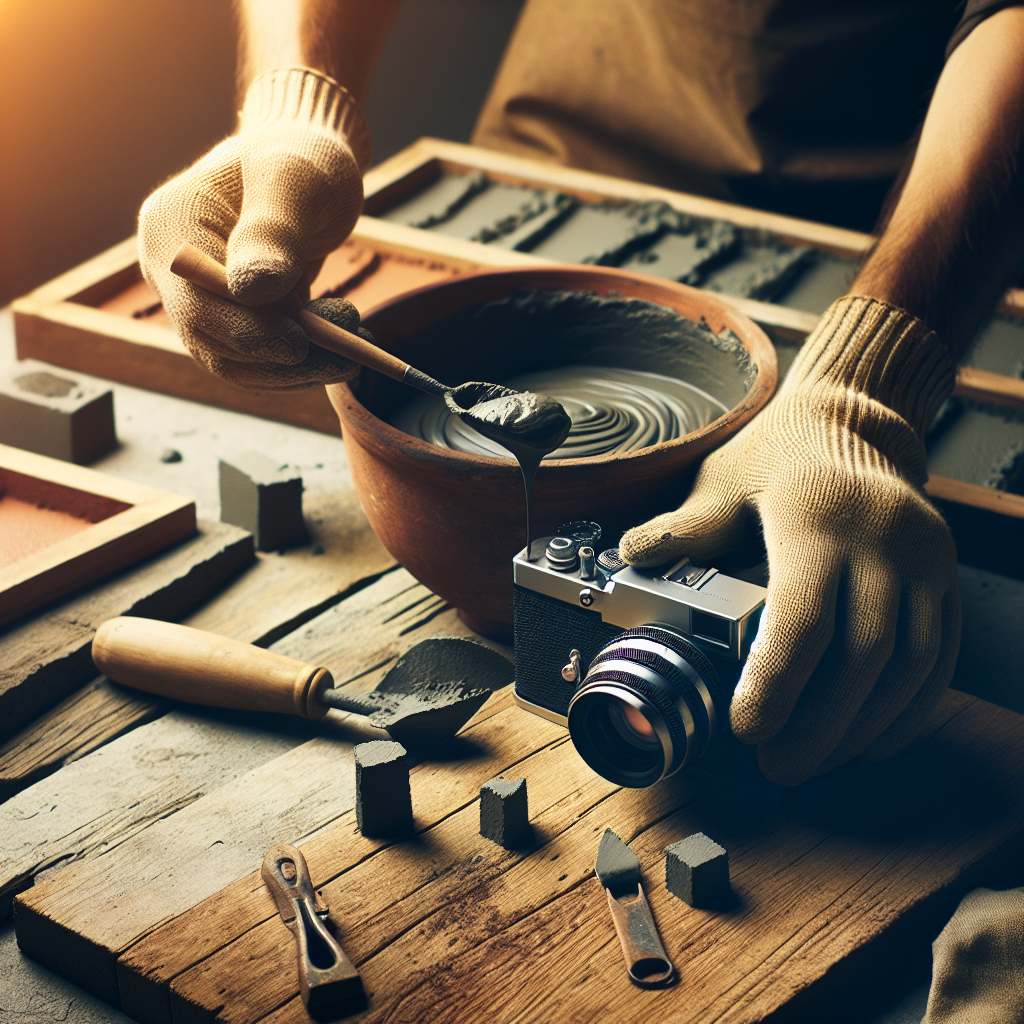“`html
Introduction: Exploring Mortar Tinting In Construction
Are you aware that the color of the mortar in a building can have a significant impact on its overall appearance? Indeed, this is why the process of mortar tinting is finding increased use in the modern construction industry.
This article will shed light on the concept of mortar tinting – a unique color enhancement process for our buildings. We’ll break down what it is, its purpose, the various types and methods, and the pros and cons. Further, we’ll explore the materials involved and the steps to performing mortar tinting. In addition, we’ll also touch on how it’s being employed in the construction industry and consider the cost factors involved.
For those interested in construction concepts, here’s your chance to add one more to your knowledge bank. Ready to learn something new? Let’s get started.
Understanding Construction Concepts: What is Mortar Tinting?
Definition of Mortar Tinting
Mortar tinting is a process used in construction to change or enhance the color of mortar joints, primarily for aesthetic appeal. This technique is often employed to ensure the mortar matches or complements the color of the surrounding brickwork or masonry.
Why Use Mortar Tinting?
- Consistency: Achieves a consistent look in renovations or extensions where new mortar must blend with old.
- Aesthetics: Enhances the visual appearance of a building, making it more appealing.
- Customization: Offers the ability to customize the color scheme of a building’s exterior.
Types of Mortar Tinting
There are several methods used for mortar tinting, each with its own advantages and ideal application scenarios.
Pigmented Additives
Adding color pigments directly into the mortar mix before application ensures uniformity and permanence.
- Advantages: Durable and integrated into the mortar.
- Considerations: Requires precise mixing to ensure consistency.
Surface Staining
After the mortar has set, a stain is applied to the surface to achieve the desired color.
- Advantages: Flexibility in color changes post-application.
- Considerations: May require re-application over time due to weathering.
Pros and Cons of Mortar Tinting
| Pros | Cons |
|---|---|
| Improves aesthetic cohesion. | May require maintenance or re-tinting. |
| Increases property value. | Initial cost can be higher than untinted mortar. |
Considerations When Choosing Mortar Tinting
When deciding on mortar tinting, it’s important to evaluate several factors:
- Project Scope: Tint choice may vary depending on whether it’s a new build or refurbishment.
- Climate Conditions: Consider the long-term effects of weather on color retention.
- Local Regulations: Check if there are any specific guidelines or restrictions in your area regarding exterior color alteration.
Real-World Applications
Mortar tinting is commonly applied in various constructions like historical building restorations, contemporary architectural designs, and neighborhood developments to ensure a cohesive look.
For further details on mortar applications, you can check comprehensive guides available here.
Main Steps: The Process of Mortar Tinting
The Materials Required for Mortar Tinting
Mortar tinting typically involves the use of powdered or liquid dyes which are carefully mixed with the main mortar ingredients of sand, lime, and cement. The choice of dye is important since it significantly affects the final result. Dyes of low quality may fade over time, leading to inconsistent aesthetics.
- Quality: High-quality dyes are resistant to UV light and harsh weather conditions, ensuring longevity.
- Variety: Dyes come in numerous colors, providing vast options for customization.
- Quantity: It’s vital to measure the right amount of dye to achieve the desired color.
Key Steps in Mortar Tinting
Performing mortar tinting requires a level of precision and careful attention to detail to achieve the desired results.
Mixing the Dye
The first step involves adding the dye to the dry mortar mix. Uniformity is key here, as this can make or break the overall look.
Adding Water
Next, water is cautiously added. It’s imperative to remember that too much water can dilute the color, while too little could result in a poorly mixed batch.
Application
Finally, the tinted mortar is ready to be applied. However, it’s important to keep in mind that the final color is revealed only after the mortar is completely dry.
Selection of Mortar Dyes
As mentioned earlier, dyes play a significant role in the tinting process. Here are the primary types you’ll encounter:
Mineral-Based Dyes
Extracted from earthy resources, these dyes offer robust, long-lasting coloration.
Chemical-Based Dyes
These dyes contain pigments produced chemically and are known for their vibrant color options.
Natural Dyes
Extracted from plants and other natural sources, these dyes provide subtler tones, fitting for certain rustic or historical aesthetics.
Usage of Mortar Tinting in Construction Industry
In the construction industry, the popularity of mortar tinting has grown. Many modern developers employ the technique to maintain color uniformity across large developments, giving entire neighborhoods a consistent aesthetic. Equally, tinted mortar is used in civil engineering projects, where it can enhance the visibility and aesthetic appeal of structures such as bridges or roadway elements.
For more specific knowledge and tips on mortar tinting, explore the information available on NACHI – a reputable resource for construction professionals.
Investigating the Benefits and Drawbacks of Brick Tinting in Construction
Definition and Purpose of Brick Tinting
Brick tinting is a process used in construction to alter or enhance the color of bricks. This technique is mainly used for aesthetics, allowing bricks to match or complement surrounding structures or achieve a desired color scheme for a building or renovation project.
Advantages of Brick Tinting
- Customization: Offers a wide range of colors that can be used to achieve specific design goals.
- Flexibility: Allows for adjustments in color that can be tailored to client preferences or architectural styles.
- Adaptability: Makes it possible to match new bricks to older, weathered ones during repairs or extensions.
- Non-Destructive: Unlike painting, tinting does not seal the surface, allowing the brick to breathe and maintain its structural integrity.
Drawbacks of Brick Tinting
- Initial Cost: The upfront expense may be higher compared to leaving the bricks in their natural state.
- Skill-Dependent Application: Requires skilled application to achieve uniform coloration and prevent streaks or patches.
- Weathering Over Time: Though high-quality tints can last many years, exposure to harsh weather can gradually fade the tint.
Comparing Brick and Mortar Tinting
| Aspect | Brick Tinting | Mortar Tinting |
|---|---|---|
| Aesthetic Impact | Changes the overall color of the façade | Enhances or matches mortar joints |
| Application Complexity | Requires precision for seamless appearance | Involves precise mixing or surface application |
| Longevity | Potentially long-lasting but may require re-tinting | May need maintenance due to weathering |
| Cost | Higher initial investment | Varies based on method chosen |
Considerations for Brick Tinting Decisions
When deciding if brick tinting is suitable for your project, consider the following factors:
- Building’s Age and Style: Older buildings or those with historical significance might benefit more from tinting to preserve appearance.
- Weather and Climate: In regions with extreme weather, extra care should be taken in selecting durable tints resistant to fading.
- Long-term Maintenance: Evaluate the cost and practicality of future maintenance to keep the color in its best condition.
- Local Regulations: Investigate any local guidelines or restrictions regarding exterior changes or treatments.
Brick tinting can significantly enhance a building’s aesthetic appeal when carefully executed and maintained. For further reading on construction materials and color customization, check out resources available on This Old House, a trusted source for home improvement and architectural design tips.
Evaluating the Cost of Colored Mortar
Is Colored Mortar More Expensive?
The cost of colored mortar tends to be higher than standard, untinted mortar, driven largely by the specific materials and the processes involved.
- Material Costs: Colored mortar involves additional materials such as dyes or pigments to achieve the desired hue. High-quality pigments are crucial for ensuring longevity and resistance to fading, but they come at a premium.
- Mixing and Application Complexity: Creating a consistent color mix requires precision to avoid inconsistencies that could lead to aesthetic issues. This level of skill might increase labor costs compared to using regular mortar.
- Custom Orders: Many projects may require custom color batches to match specific design goals, which can incur additional costs both in materials and in time spent mixing the mortar.
Pricing Factors for Colored Mortar
Several elements influence the pricing of colored mortar, making direct comparisons to standard mortar challenging.
| Factor | Impact on Cost |
|---|---|
| Pigment Quality | Higher-quality pigments result in higher costs due to their color stability and longevity. |
| Batch Size | Larger batches might reduce per-unit cost due to economies of scale. |
| Project Size | Larger projects could require more precise color matching, increasing labor and material costs. |
| Supplier and Location | Costs can vary by supplier and geographic location due to differences in material availability and shipping costs. |
Benefits Justifying the Extra Cost
Although more expensive, colored mortar offers advantages that may justify its use for certain projects.
- Aesthetic Integration: Professionally colored mortar can significantly enhance the cohesion and visual appeal of masonry work, particularly important in high-profile projects.
- Increased Property Value: A well-matched mortar can improve the overall impression of a property, potentially increasing its market value.
- Design Flexibility: Colored mortar allows architects and designers to fully integrate the mortar into their color schemes, offering more creative freedom.
For homeowners and developers considering colored mortar, it’s essential to weigh these considerations against project budgets and expectations. For construction enthusiasts seeking more in-depth comparisons and recommendations, [This Old House](https://www.thisoldhouse.com/) provides additional resources that may be useful in decision-making.
In Conclusion: Understanding the Art and Application of Mortar Tinting
Mortar tinting is an intentional construction technique applied to enhance or modify the color of mortar joints for an aesthetic appearance. It allows for consistency, aesthetics enhancing, and customization, which give buildings a spruced-up look. Various types of mortar tinting like pigmented additives and surface staining each come with their unique pros and cons, making consideration of project scope, weather conditions, and local regulations crucial when choosing the desired method.
Colored mortar indeed costs more than the standard, untinted type, attributable to the premium quality pigments that ensure color stability and longevity, the precision needed in making a consistent color mix, and the possibility of custom color batch requirements. However, the aesthetic integration, increased property value, and expanded design flexibility it offers makes it a worthy consideration.
Frequently Asked Questions – FAQs
What is mortar tinting?
Mortar tinting is a technique used to change or enhance the color of mortar joints, done mainly for aesthetic appeal. It ensures the mortar matches the color of surrounding brickwork or masonry.
Why should I consider mortar tinting?
Mortar tinting helps achieve a consistent look while renovating or extending structures. It enhances the visual appearance of a building and offers an opportunity to customize your building’s exterior color scheme.
Is colored mortar more expensive than standard mortar?
Yes, colored mortar comes at a higher cost because of the extra materials like dyes or pigments and the sophisticated processes involved in its creation.
What are the benefits of using colored mortar?
Colored mortar enhances the visual appeal of masonry work, potentially raises property value, and offers more creative freedom to architects and designers.
“`






